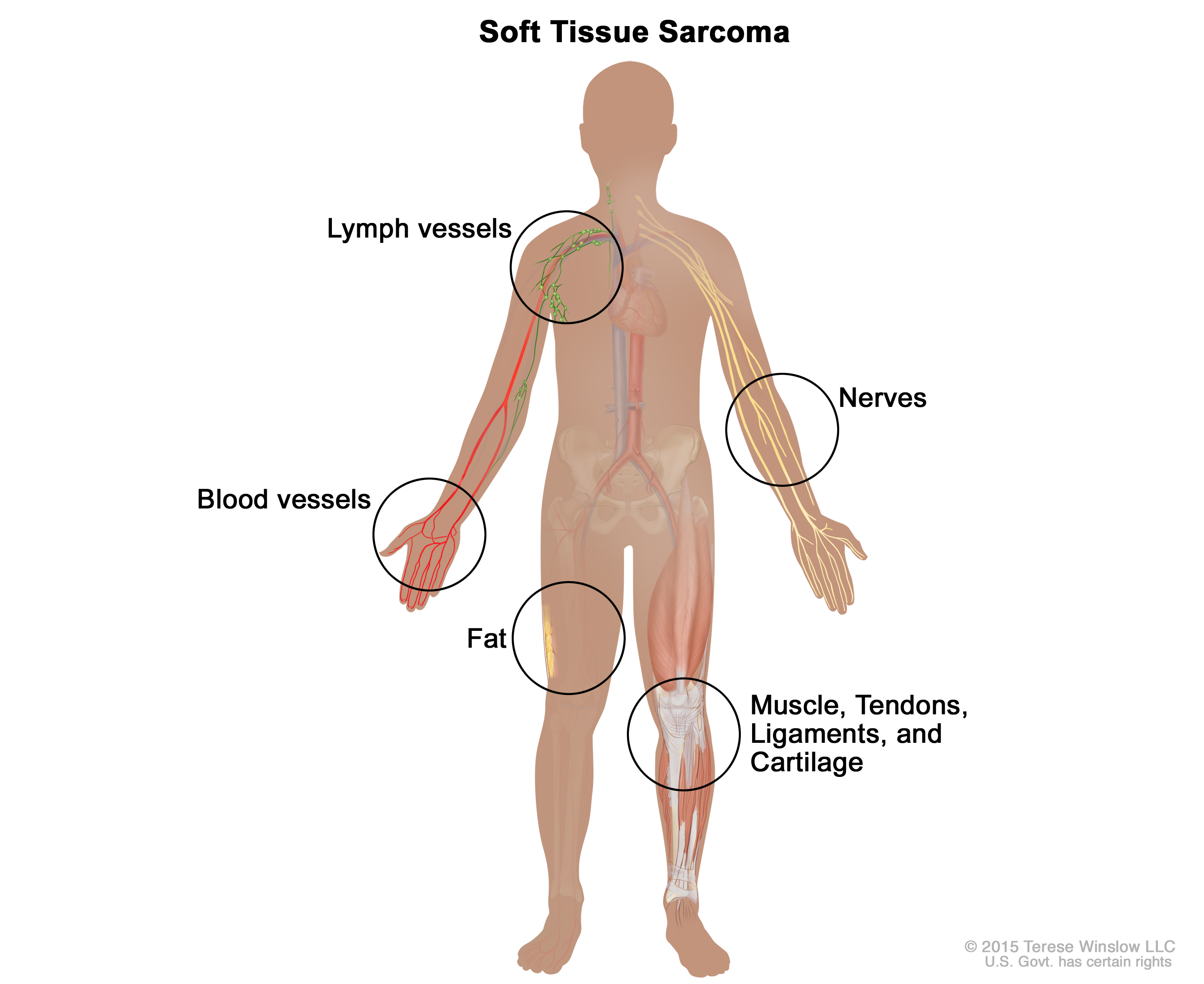Understanding Sarcoma
Sarcoma is a rare type of cancer. It forms in the body’s connective tissue, which includes bone, muscle, fat and nerves. Sarcomas can occur at any age and in any part of the body. Sarcomas are easier to treat if you catch them early, before they spread.
Sarcoma is a complex condition that requires expert care and treatment.

What is sarcoma?
Sarcoma is a cancer that starts in your connective tissue. Connective tissue is made up of cells and fibers that connect and support other parts of the body. Sometimes these cells go haywire and start to divide and multiply. These cancer cells can form a tumor.
You have connective tissue throughout your body, so sarcomas can develop anywhere. Many sarcomas grow in the arms and legs.
There are three main types of sarcoma:
- Soft tissue sarcomas grow in fat, muscles, nerves, blood vessels and deep skin. They are the most common type. They account for about 80% of all sarcomas.
- Bone sarcomas grow in bones and cartilage.
- Benign sarcomas grow in connective tissue, usually in the arms, legs, joints or abdomen. They are very rare. They are not technically cancer, but are often treated by cancer doctors. Sometimes they grow slowly and cause no problems, but sometimes they grow fast and cause pain. They can be aggressive and often come back, but do not spread.
Who gets sarcoma?
Sarcomas are rare. About 17,000 cases are diagnosed in the U.S. every year, according to the National Cancer Institute. Roughly 225,000 Americans are living with sarcoma.
Risk factors include:
- Youth: About half of all sarcomas occur before age 40. This may be because sarcomas often form during growth spurts.
- Family history: Families with rare cancer syndromes are more likely to get sarcomas. OHSU offers expert genetic counseling and testing to help you assess and manage risk.
- Other: You’re at higher risk if you’ve had radiation therapy, a damaged lymph system or been exposed to certain chemicals.

patients with bone and soft-tissue tumors.
Sarcoma survival rates
Survival statistics use a percentage known as the five-year relative survival rate. This statistic compares your chance of surviving five years after diagnosis compared to someone your age who doesn't have cancer.
Survival rates depend on the type of sarcoma. They are higher when sarcoma starts in an arm or leg, and when the cancer is caught before it spreads.
Soft tissue sarcoma: The survival rate is 82% if sarcoma is found before it spreads, according to the American Cancer Society. Ten-year survival rates are similar. This suggests that those who survive five years are likely to be cured.
Bone sarcoma: The survival rate ranges from 76% to 91% if the sarcoma is caught before it spreads.
Benign tumor: These tumors are seldom life-threatening.
It’s important to know that survival rates are averages and can’t predict the outcome for any one patient. It's also important to know that these rates reflect the treatments that were available five or more years ago.
Symptoms of sarcoma
Most often, these symptoms are not caused by sarcoma. But if they persist and no other condition explains them, talk with your doctor.
Signs and symptoms of a soft tissue sarcoma:
- A lump on an arm or leg, often not painful, that grows over weeks or months
- Pain in the abdomen
- Blood in your vomit or stool, or stools that are black and tarry
Signs and symptoms of a bone sarcoma:
- Pain in the affected bone, first only at night or when using that bone, later frequently
- Lump or mass, depending on the tumor’s location
- Fractures caused by a weakened bone
Signs and symptoms of a benign sarcoma:
- A firm, painless swelling in the arms, legs, joints, neck or chest
- Pain when the tumor presses against another part of your body
- A tingling sensation when the tumor presses against nerves
Types of soft tissue sarcoma
The most common types of soft tissue sarcoma are:
- Angiosarcoma: This type forms in blood vessels or vessels of the lymph system.
- Gastrointestinal stromal tumor (GIST): This type usually forms in the stomach and small intestine.
- Kaposi sarcoma: This type forms in the skin, lymph nodes, mouth and other places. It is caused by a virus and sometimes occurs when your immune system is under attack.
- Liposarcoma: This type forms in fatty tissue and can occur anywhere in the body.
- Rhabdomyosarcoma: This type is usually found in children. It usually develops in muscles that are attached to bone.
- Pleomorphic sarcoma: This type usually forms in arms or legs and occurs most often in older adults. It’s usually found in soft tissue but can also develop in bone.
- Uterine sarcoma: This type develops in the uterus.
Types of bone sarcoma
The most common types of bone sarcoma are:
- Osteosarcoma: This is the most common type of bone cancer. It starts in bone cells and most often occurs in teens and younger people.
- Chondrosarcoma: This type starts in cartilage cells.
- Ewing sarcoma of the bone: This type often starts in the hip, the ribs and the legs. It mostly affects children and teens.
Types of benign sarcoma
The most common types of benign sarcoma are:
- Desmoid tumor: This type can occur anywhere in the body. It is usually seen in adults. It sometimes occurs in people with familial adenomatous polyposis (FAP).
- Giant cell tumor of bone (GCTB): This tumor often forms near the knee but can also occur in other joints. It’s usually seen in people in their 20s or 30s.
- Tenosynovial giant cell tumor (TGCT): This tumor forms in the tissue around a joint where two bones meet. Left untreated, it can damage or destroy the joint.
Learn more
- Find a clinical trial for sarcoma.
- Sign up for a cancer registry. This is a way help research and stay on top of the news.
- Soft Tissue Sarcoma, American Cancer Society
- Bone Cancer, American Cancer Society
- Osteosarcoma, American Cancer Society
- Ewing Family of Tumors, American Cancer Society
- Sarcoma Foundation of America
- Northwest Sarcoma Foundation
- National Leiomyosarcoma Foundation
For patients
Call 503-494-7999 to:
- Request an appointment
- Seek a second opinion
- Ask questions
Location
Knight Cancer Institute, South Waterfront
Center for Health & Healing, Building 2
3485 S. Bond Ave.
Portland, OR97239
Free parking for patients and visitors.
Refer a patient
- Refer your patient to OHSU.
- Call 503-494-4567 to seek provider-to-provider advice.
Cancer clinical trials
Clinical trials allow patients to try a new test or treatment.
Kids and teens

Read more
Learn more about OHSU Knight Cancer Institute treatments:
- Surgery
- Chemotherapy/medical oncology
- Radiation therapy
- Immunotherapy
- CAR T-cell therapy
- Targeted therapy
Learn about our expert care for: